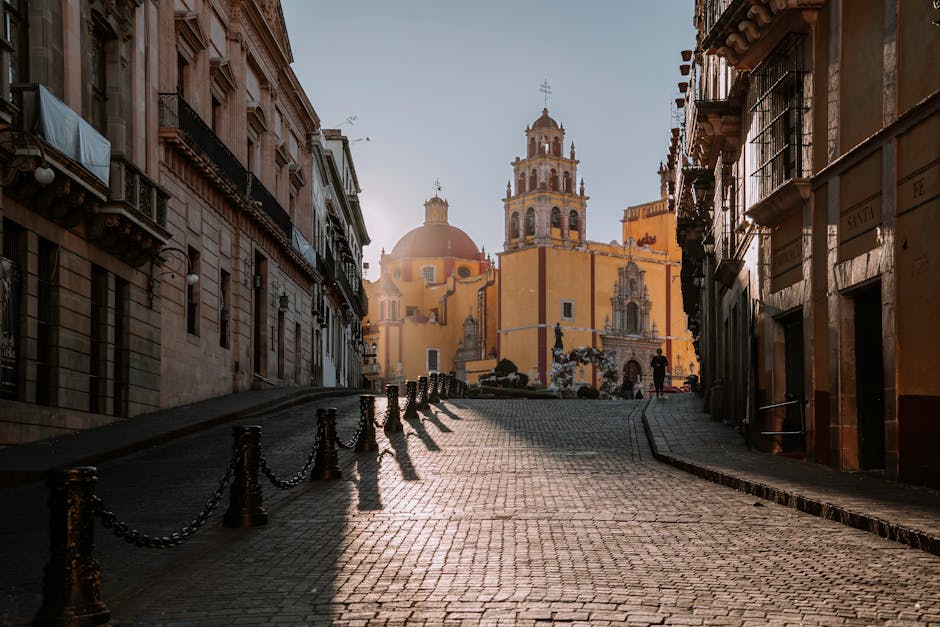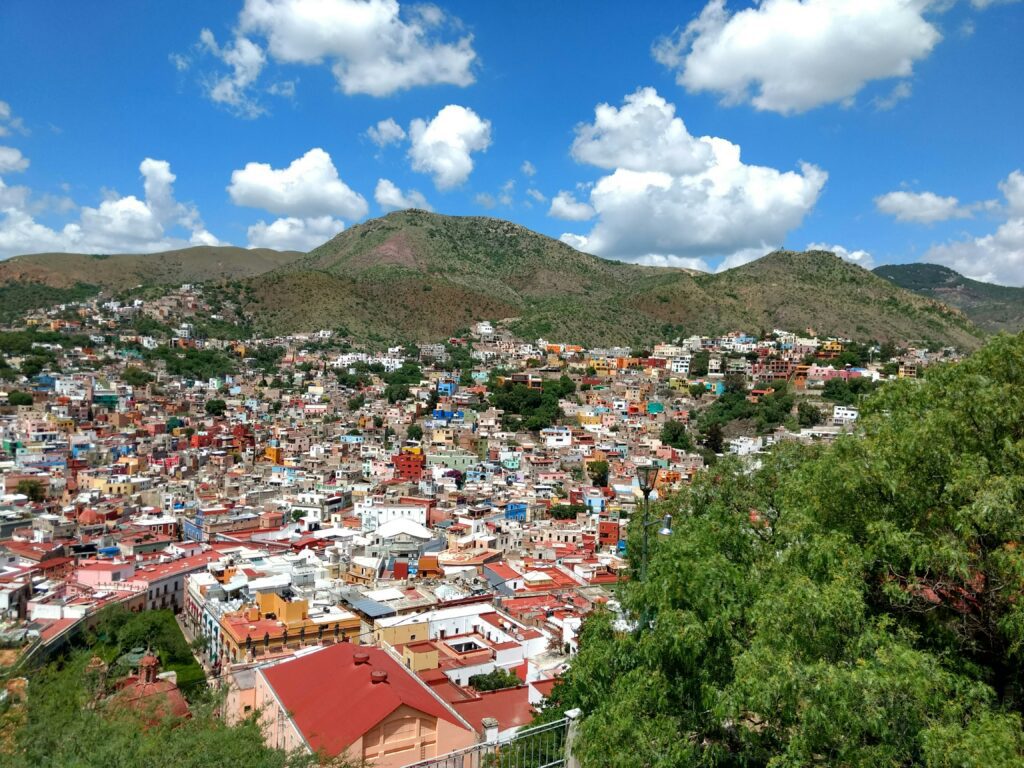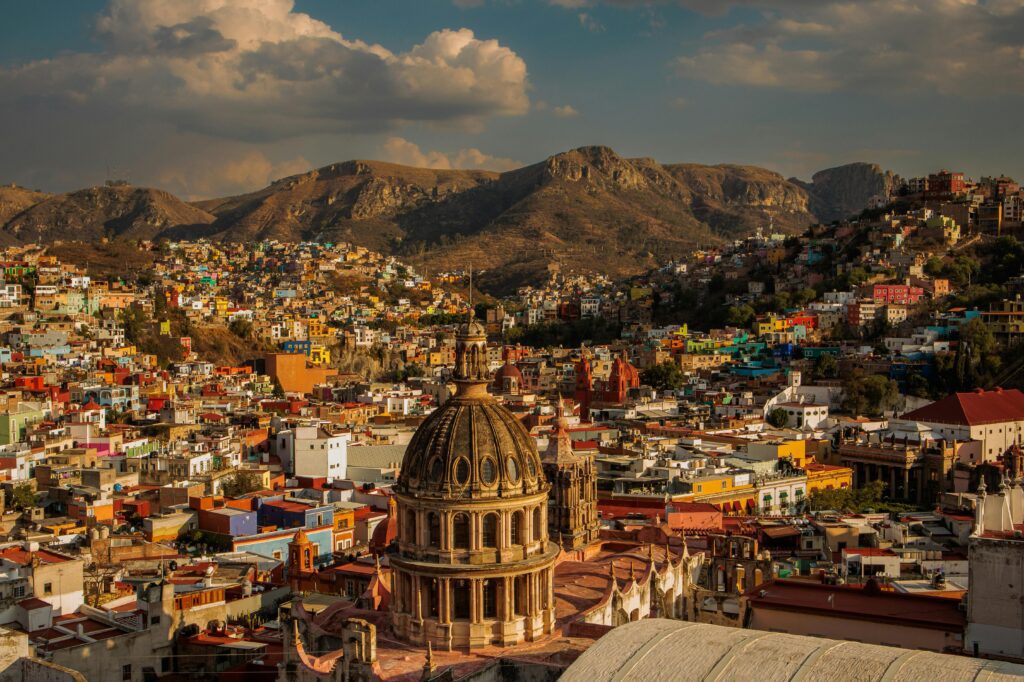“Discover Guanajuato, Mexico’s hidden gem. Explore colorful alleys, historic mines, and vibrant markets. Immerse in unique cultural experiences.”
Introduction: Why Visit Guanajuato?
Stepping into Guanajuato, Mexico, feels like entering a living painting—vivid colonial buildings cling to steep hillsides, cobblestone alleyways hum with mariachi music, and the crisp mountain air carries the scent of freshly made enchiladas mineras. This UNESCO-listed city, once the world’s largest silver producer, now dazzles travelers with its rich history, vibrant festivals, and labyrinthine charm.

Key Highlights
✔ Iconic Landmarks: Callejón del Beso, Alhóndiga de Granaditas, Teatro Juárez
✔ Cultural Gems: Cervantino Festival (October), Día de los Muertos (November)
✔ Unique Experiences: Underground tunnel drives, silver mine tours, callejoneadas (nighttime musical walks)
Personal Anecdote: My first evening in Guanajuato, I stumbled upon a spontaneous callejoneada—a troupe of musicians led us through dimly lit alleys, sharing ghost stories and serenading us with folk songs. The sound of guitars and laughter echoed off the pastel-painted walls, and for a moment, time seemed to stand still. It was pure magic.
Planning Your Trip
Best Time to Visit Guanajuato
- October: Ideal for the Cervantino Festival (arts/culture) and pleasant weather (60–75°F). The festival transforms the city into a global stage, with performances ranging from opera to avant-garde theater.
- November: Experience Día de los Muertos with ofrendas (altars) and parades. The Jardín de la Unión fills with marigolds and candlelight, creating an ethereal atmosphere.
- April–June: Sunny days (70–85°F), fewer crowds. Perfect for hiking to Cerro de la Bufa for sunrise.
- Avoid: July–September (rainy season; some attractions close). Afternoon storms can flood the tunnels, disrupting transport.
How to Get There
- By Air: Fly into Del Bajío International Airport (BJX), 30 minutes from downtown. Direct flights from Mexico City, Dallas, and Houston. Taxis to the city center cost ~$20 USD; Uber is cheaper (~$12).
- By Bus: Primera Plus buses from Mexico City (4.5 hours, ~$25 USD) offer reclining seats and Wi-Fi. Arrive at Guanajuato’s Central de Autobuses, then take a local bus ($0.50) or taxi ($5) to downtown.
- Transport Tip: Use the city’s underground tunnels (originally flood channels) to avoid traffic. Rent a car only if you’re comfortable navigating narrow, winding streets.
Where to Stay
| Budget | Mid-Range | Luxury |
|---|---|---|
| Hostal del Campanero ($15/night) | Hotel Edelmira ($80/night) | Hotel Boutique 1850 ($200/night) |
| Social vibe, rooftop views | Colonial charm, central location | Panoramic city views, spa |
Budget Pick: Hostal del Campanero’s rooftop is legendary—imagine sipping pulque (a pre-Hispanic fermented drink) while the city’s church bells chime at dusk.

Mid-Range Gem: Hotel Edelmira’s courtyard, draped in bougainvillea, feels like a secret garden. Their complimentary breakfast includes chilaquiles with house-made salsa verde.
Luxury Splurge: Hotel Boutique 1850’s spa offers a temazcal (traditional sweat lodge) experience. Post-treatment, unwind in their library with a 19th-century book on Guanajuato’s mining history.
Personal Anecdote: At Hostal del Campanero, I bonded with fellow travelers over mezcal while watching sunset hues paint the city—a backpacker’s dream. One night, a local artist joined us, sketching caricatures as we shared travel tales.
Note: Book early for festival dates—rooms fill fast!
3-Day Guanajuato Itinerary
Day 1: Historic Heart & Hidden Alleys
- Morning:
- Plaza de la Paz: Start at this leafy square, where silver barons once plotted. The Basílica Colegiata (free entry) dazzles with its canary-yellow façade and gilded altarpieces. Climb the bell tower ($2 tip to the caretaker) for a pigeon’s-eye view.
- Monumento al Pípila: Taxi ($5) or hike 10 minutes up Callejón del Calvario. The statue honors a miner who torched the Alhóndiga’s door during Mexico’s independence war. The vista—ochre rooftops tumbling into valleys—is worth the sweat.
- Afternoon:
- Lunch at Truco 7: A 19th-century tavern serving enchiladas mineras ($8)—tortillas smothered in guajillo chili sauce, topped with pickled carrots and potatoes. Pair with agua de jamaica (hibiscus tea).
- Alhóndiga de Granaditas: This fortress-turned-museum ($3 entry) houses Diego Rivera murals depicting Mexico’s struggle for freedom. Don’t miss the macabre brasero (a cage where insurgents’ heads were displayed).
- Evening:
- Callejoneada: Join the 8 PM troupe at Jardín de la Unión ($5). My guide, Don Rafael, played the trompe (a jaw harp) while recounting tales of star-crossed lovers in the Callejón del Beso.
Day 2: Mines & Museums
- Morning:
- La Valenciana Mine: A 20-minute taxi ride ($10) to this 18th-century marvel. The 60-meter-deep shaft tour ($4) reveals glittering mineral veins. Nearby, Templo de San Cayetano drips with gold leaf—funded by the mine’s profits.
- Afternoon:
- Lunch at Casa Valadez: Their sopa de hongos (wild mushroom soup, $12) is a revelation. Save room for cajeta (goat’s milk caramel) flan.
- Museo de las Momias: The infamous mummy museum ($5) displays naturally preserved 19th-century corpses. The “Smallest Mummy” (a fetus) is haunting; photography bans respect the deceased.
- Evening:
- Teatro Juárez: Check schedules for the Guanajuato Symphony Orchestra. Even if you don’t attend, admire the Moorish façade lit by gas lamps.
Day 3: Day Trips & Local Flavors
- Morning:
- San Miguel de Allende: Primera Plus buses ($10 round-trip) leave hourly. Wander the Jardín Principal, then visit La Aurora Art District (former textile factory turned galleries).
- Afternoon:
- Cooking Class at El Mesón de los Poetas: Learn to toast chilies for mole ($35/3 hours). My instructor, Abuela Lupe, swore the secret was “stirring with love.”
- Evening:
- La Clave Azul: A speakeasy behind an unassuming door. Sip charanda (rum) cocktails ($7) as jazz trios play. Try the Piedra Lunar—mezcal, lime, and prickly pear syrup.

Guanajuato Travel Tips
Essential Advice
- Safety: Stick to tourist areas; avoid flashing valuables. Petty theft peaks during festivals.
- Transport: Uber is safer than unmetered taxis. Walking is best, but wear grippy shoes—cobblestones are slick after rain.
- Packing List:
- Altitude prep: At 6,600 ft, hydration is key. Coca tea (sold at markets) helps with dizziness.
- Cash: Many small shops only accept pesos. ATMs at Banorte (Av. Juárez) have low fees.
Local Etiquette
- Greetings: A handshake suffices, but locals appreciate “¿Cómo está?” (How are you?).
- Tipping: 10% at cafés, 15% at restaurants. Tip callejoneada guides $2–$5.
- Photos: Always ask before snapping shots of street vendors or indigenous performers.
Backpacking Tip: Buy a Guanajuato Card ($30/3 days) for discounts at 30+ attractions, including the Museo del Pueblo.
FAQs About Guanajuato
Q: Is Guanajuato safe for solo travelers?
A: Yes, but take precautions. Avoid deserted alleys after midnight. Female travelers report feeling safer here than in larger Mexican cities.
Q: How do I navigate the underground tunnels?
A: Rent a car (if confident) or take a Túnel Tour ($15, includes history narration). Key routes: Túnel La Galereña (connects to Plaza de la Paz) and Túnel Los Ángeles (leads to Mercado Hidalgo).
Q: What’s the best local dish?
A: Enchiladas mineras (mentioned above), but also try guacamayas—a street-food sandwich of pork rinds, avocado, and fiery salsa, best eaten at Puesto La Guacamaya ($3).
Q: Can I visit the mines without a tour?
A: No—guides ensure safety and share lore (e.g., how miners communicated via coded candle flickers). Boca Mina offers helmet rentals.
Q: Are credit cards widely accepted?
A: Yes in hotels/restaurants, but markets and buses are cash-only. Currency Exchange Tip: Casa de Cambio Guanajuato (near Jardín de la Unión) offers better rates than airports.
Conclusion: Start Your Adventure Today!
Guanajuato is a city that lingers in your memory—its golden sunsets, echoing alleyway melodies, and the warmth of its people. Whether you’re tracing silver-mining history or dancing at a street festival, every moment here feels alive with story.
Keywords:
1. “Guanajuato Mexico travel guide”
2. “Best time to visit Guanajuato Mexico for festivals”
3. “What to do in Guanajuato Mexico: Top attractions and hidden gems”
4. “Guanajuato Mexico’s unique alleyways: A walking tour”
5. “Discovering the historic mines of Guanajuato Mexico”



